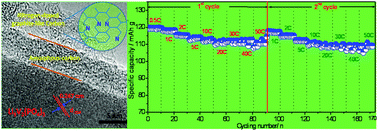Nitrogen-doped carbon coated Li3V2(PO4)3 derived from a facile in situ fabrication strategy with ultrahigh-rate stable performance for lithium-ion storage†
Abstract
A nitrogen-doped carbon coated Li3V2(PO4)3 cathode material is prepared by using a very simple in situ approach. The Li3V2(PO4)3 particle is uniformly encapsulated by a nitrogen-doped carbon layer, where a carbon coating layer exists, nitrogen-doping also exists. N-doping on the carbon layer significantly increases the electronic conductivity of as-prepared Li3V2(PO4)3 sample, and thus, this Li3V2(PO4)3/C+N demonstrates ultrahigh rate performance and excellent cycling stability for lithium storage. When the discharging rate is increased from 0.5 C to 50 C, its capacity of 119.5 mA h g−1 decays to 110.8 mA h g−1 and an amazing capacity retention of 93% is achieved. This in situ synthetic approach of a nitrogen-doped carbon coated Li3V2(PO4)3 cathode reported herein is highly efficient and easily realized in industrial applications and moreover, is able to be extended to modify other electrode materials in which carbon-coating is indispensable, such as LiFePO4etc.


 Please wait while we load your content...
Please wait while we load your content...